#eastern dobsonfly
Text
Bug of the Day

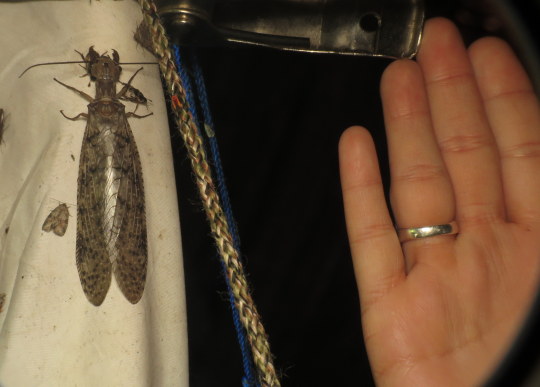
Ok, there were lots of votes for fuzzy (tomorrow, I promise), but I was inspired by @cccshutdown requesting "bring me the Longest beast you know" to post this ginormous female dobsonfly we found at the lights a couple of weeks ago. She is Eastern Dobsonfly (Corydalus cornutus), she is Megaloptera, and she is FIERCE!!
#Eastern dobsonfly#Corydalus cornutus#Corydalus#Corydalidae#dobsonfly#Megaloptera#insect#FIERCE#bug of the day#BotD
540 notes
·
View notes
Text

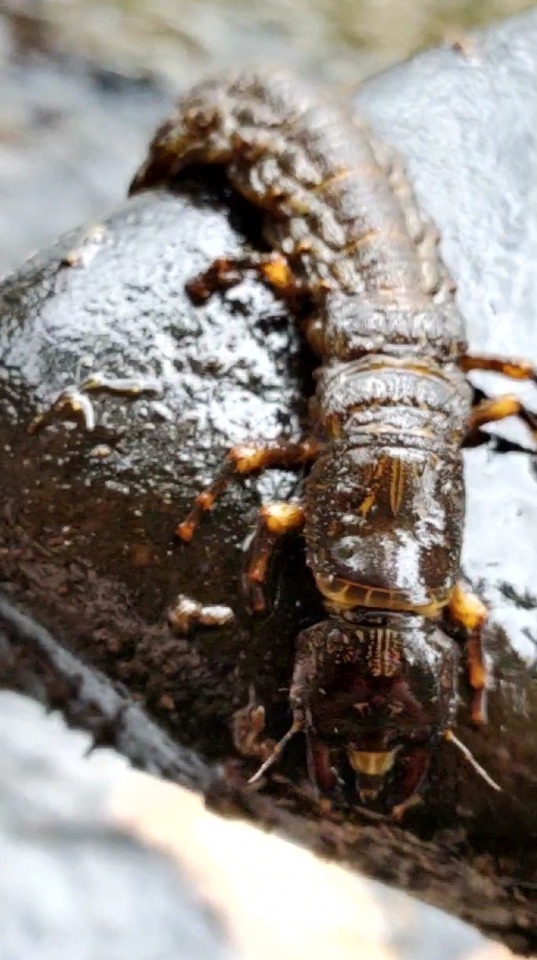
Eastern dobsonfly (Corydalus cornutus) larva I found while hanging out in the river in Northeastern Pennsylvania (US) last year.
Dobsonfly larvae, also known as hellgrammites, are one of the top invertebrate predators in fast-moving streams. They tend to hide under rocks and use their sharp mandibles to capture and eat prey. These mandibles can also deliver a painful (but harmless) bite, so definitely be careful handling them!
Larvae can get up to 3.5 inches (9 cm) long. Since they're large and relatively common, many of the local fishermen like to use them as bait (which may or may not be problematic).
These insects spend 1-3 years as larvae and pupate outside of the stream under a rock or log. The adults are huge. The male can be up to 5.5 inches (14 cm) long and has massive mandibles that are intimidating but harmless. Adults aren't known to feed, and they only live for about a week, just enough time to mate and lay eggs.
#dobsonfly#dobsonfly larva#hellgrammite#bug#Corydalus cornutus#Corydalidae#Megaloptera#eastern dobsonfly#nature#bugs#biodiversity#animals#inaturalist#arthropods#bugblr#entomology#insect appreciation#creature#invertebrates#aquatic life#pennsylvania#river#predator#nature appreciation#cool facts#biology#science#interesting
18 notes
·
View notes
Text
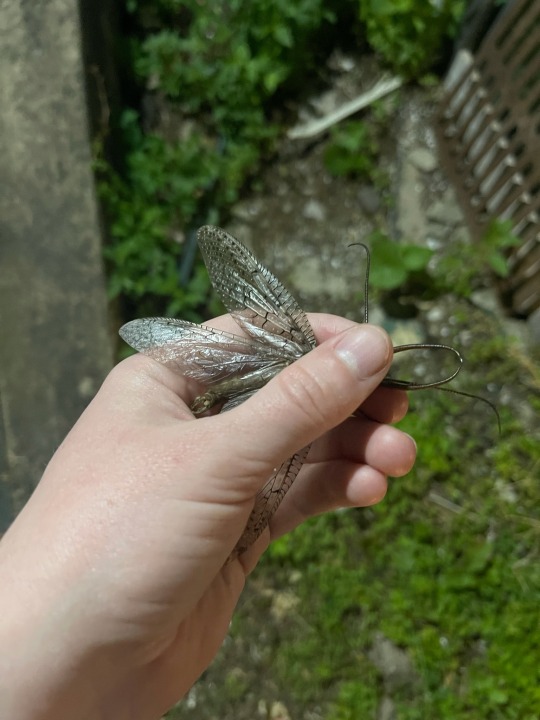


first bigman of the year, was loitering outside my front door
Corydalus cornutus
169 notes
·
View notes
Text



@schrodingers-cate submitted: Hi again, from [removed] (remove please)! Heres another lovely set of bugs ive been collecting pictures of. Im really interested in the ID for these, ESPECIALLY the really large larva . He was so big i spotted him from a second story window of the house next to the driveway he was crawling on. If it helps, that larva was right next to a small creek on a rainy day. Thanks so much!!
Great group of weird pals! The beetle is an oak timberworm weevil and the green fellow looks like a crane fly in the genus Erioptera, mayyyyybe Erioptera chloroplylla. The big larva is a dobsonfly! They’re aquatic as larvae, but leave the water to pupate :)
#animals#insects#bugs#submission#beetle#weevile#oak timberworm weevil#fly#diptera#crane fly#Erioptera#Erioptera chlorophylla#dobsonfly#eastern dobsonfly#larva
85 notes
·
View notes
Photo


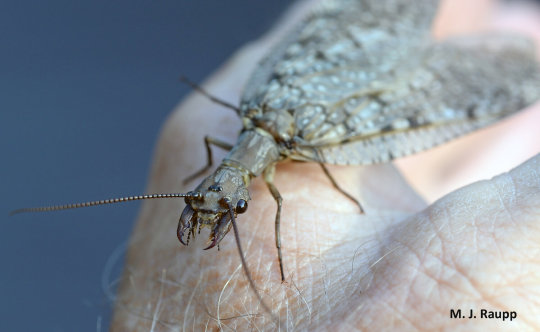
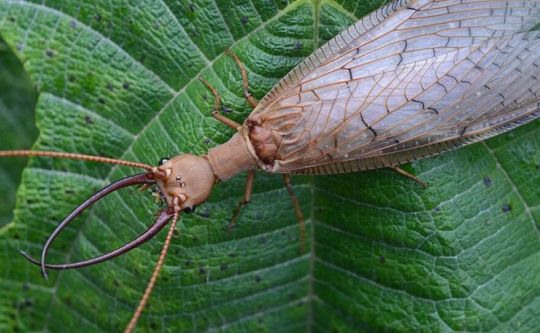
Darling Eastern Dobsonflies
requested by @skyroller
Eastern dobsonflies (Corydalus cornutus) is a distinct species of insect commonly found in the eastern rivers of North America. They go through several stages over the course of their lives, which in total can last as long as three years. They begin as eggs, laid close to water in clusters of up to 1,000. These clusters often resemble bird droppings as a form of camouflage. About a week or two after being laid, the eggs hatch into the form they spend most of their lives in-- the larvae known as hellgrammites.
Hellgrammites are aquatic, spending most of their time under river rocks. Over the course of 1-3 years, these larvae can molt up to 12 times. In late spring or early summer they finally emerge from the water, burrow into the soft soil of the river’s edge, and pupate. In colder regions C. cornutus remains dormant throughout the winter, but in warmer regions adults emerge after only 1-2 weeks. Male adults use their powerful jaws to fight each other for access to females, and after successfully mating both males and females die.
Larval C. cornutus have dark brown or black segmented bodies with 3 pairs of legs. Protruding from each segment is a filament with a gill tuft at the base, which they use to breathe under water. In addition to these, hellgrammites have a set of external respiratory openings called spiracles, with which they can also breathe on land. Adult dobsonflies look significantly different. The abdomen, while still segmented, is lightened to a tan and becomes more elongated; in total they can be up to 14cm long. The filaments are gone, replaced with 2 sets of large wings, which reach spans of 13cm. Adults also have a pair of antennae, which they can use to locate the chemical signals emitted by potential mates. Male C. cornutus sport a large, curved set of mandibles, which make up almost half their body length.
Because adult dobsonflies die soon after mating, they don’t eat. Hellgrammites, however, consume a wide range of smaller insects and larvae, mollusks, and crustaceans, making them important low-level predators in their native rivers. Both larvae and adults host a large number of predators including fish, crayfish, birds, and bats. Hellgrammites are also a popular choice of bait for fishermen. To protect themselves from predators, larvae and adults have mandibles that can deliver a powerful bite. They are also active primarily at night to avoid diurnal predators.
Conservation status: The eastern dobsonfly has not been evaluated by the IUCN. However, over collection for fishing may deplete populations, and larval dobsonflies are vulnerable to river pollution and deplition.
Photos
Jim Rathert
Isaac Szabo
Michael Raupp
Geoff Gallice
#eastern dobsonfly#Megaloptera#Corydalidae#dobsonflies#insects#arthropods#freshwater fauna#freshwater arthropods#rivers#river arthropods#deciduous forests#deciduous forest arthropods#North America#eastern north america#animal facts#biology#zoology#requested
66 notes
·
View notes
Text

Insektober day 9: Seaside
Ambrose and Thoran rest beside the sea at Khord Shore, allowing the local water mites to crawl over them as they lean against each other. Ambrose is a notorious pirate who wishes to be a captain someday, but is held back by his boss. Thoran wants to live a quiet and peaceful life, but always finds herself entangled with the pirates. The two hate each other, and yet they still sit together under the sunset. What must draw them to each other?
Weirdly tender piece between 2 underexplained characters of mine. I absolutely love Thoran and will talk abt her any chance I get, but there's not much of her on this blog! And Ambrose... I straight up didn't post him at all lol! I'll tell you about them right now, then! Also since it's quick, regarding the water mites: they're kind of like pests to the residents of Khord Shore, though some think they're cute and keep them as pets. They're like rats but semi aquatic and arachnids LOL. They're not anthropomorphic, kind of like how the Amorites are in the show.
Ambrose is a spotted lanternfly. I basically designed him as a central villain for a certain episode of my insektors rewrite that I haven't gotten to yet... he's something of a megalomaniac, though his boss usually "keeps him in check"... by manipulating him. He likes to take on a leading role, though often thinks he is held back by his fellow pirates. He knows as well as any other pirate in his crew that it's dangerous for him to fight alone, but he wishes his backup would. y'know. back him up. He wants Thoran to go on raids with him, but she hates the pirate life & wishes to stay out of trouble. It's frustrating-- Thoran's one of the only people Ambrose trusts, but he hates how stubborn she can be!
Thoran is an eastern dobsonfly. She's part of the same rewrite story as Ambrose, though she is more of a grey figure-- she's a Yuk, but isn't allied with the other Yuks around her. She is kind to those who are kind to her, regardless of alignment essentially. Also, she is transgender! Though you may have already guessed that if you're familiar with dobsonflies in real life. Unlike Krabo, Greeb, Moritz, and Zarojo, Thoran doesn't have access to medication so mostly relies on social presentation. Dobsonfly gender roles are interesting as well-- female dobsonflies are expected to be strong and fierce, while males are just supposed to be pretty (their mandibles are purely decorative, they're soft and not good for fighting!)-- so Thoran's been literally fighting her entire life to gain respect from her peers. That's how she lost her eye and part of her mandible! She's actually proud of the jaw scar-- the stump that's left of her mandible looks much more like a cis female dobsonfly's would. She's been thinking about getting her other mandible filed down or cut off, but she thinks it wouldn't be "honorable" or "fair" if she didn't lose it in a real fight. So I guess she has some self-destructive tendencies going on, though she definitely doesn't see it that way-- she thinks she NEEDS to risk her life in order to be viewed as 'valid' by her fellow Yuks. She doesn't have much support, so often results to a life of isolation and reclusivity. My god I rambled a lot abt her LOL. I LIKE HER A LOT OK...
Also to clarify about yuk/krud terminology-- 'Yuks' are an umbrella term for the whole group of Insektors that are dull colors and don't fly, while 'Kruds' are specifically the Yuks that live in Krud City. So every Krud is a Yuk but not every Yuk is a Krud! Joyces and Verigreens are the same-- they're only 'Verigreens' if they live in Flowered City. Also I saw Saw X today finallY!!!! it was so fucking good lol.
#art#traditional art#insektors#insektober#daily drawing#bugs#completed#marker art#pen art#insektors OC#Ambrose#Thoran#water mites#spotted lanternfly#eastern dobsonfly#Yuks#Khord Shore#Yukdom
1 note
·
View note
Text
Here are some pictures that I took of a moth. They aren’t great… but the moth is cool :)


Also: my fiancé caught a pic of this fella

#bugs#bugblr#pretty sure it’s a beautiful wood-nymph moth and an eastern dobsonfly… but I might be wrong (i’m not the best at identification)#*shrugs*#love the moths lil leggies tho#they’re so cute
2 notes
·
View notes
Text
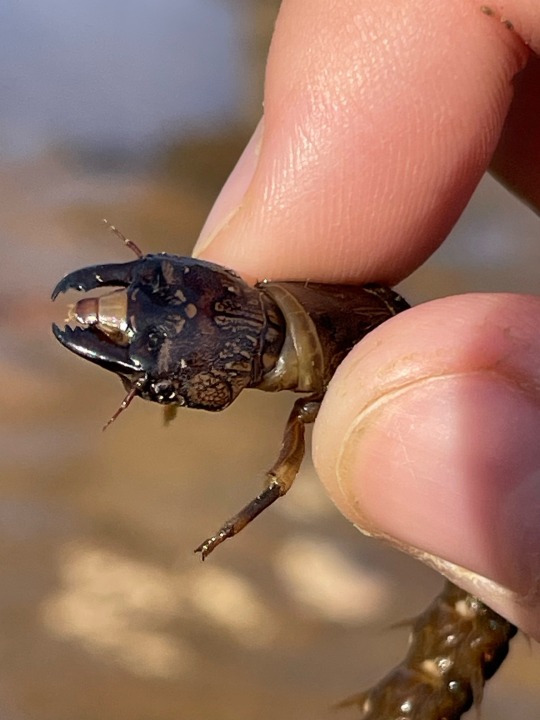
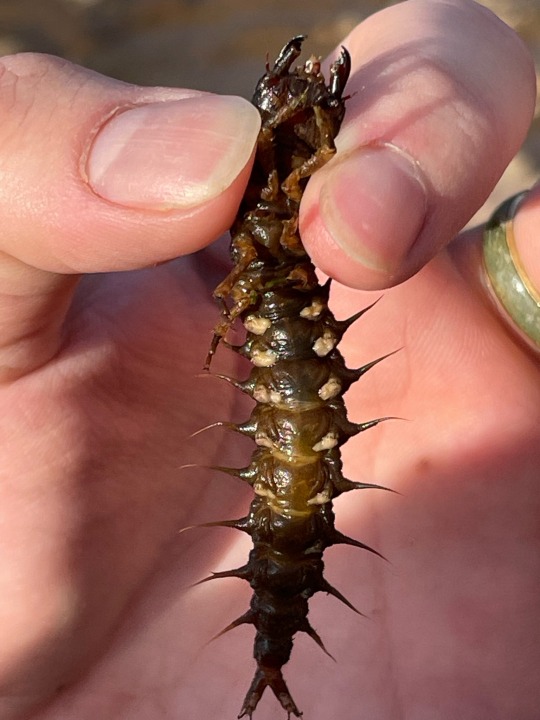

hellgrammite!!! (eastern dobsonfly nymph)
I love these so much, their patterns are so beautiful. They can bite pretty hard, but i’ve never had one bite me at all. otherwise they’re harmless!
you can see its abdominal gills as well, which are really fucking cool !!
#hellgrammite#fishing#fishblr#conservation#nature#biology#insects#bugs#entomology#macroinvertebrates#bugcore#wildlife#wildlife photography#bug photography
217 notes
·
View notes
Text
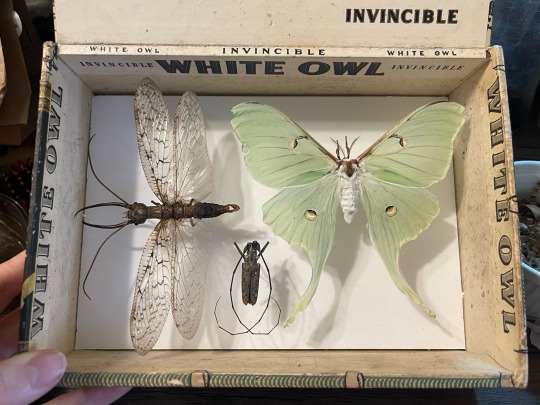
recent pins. still reconstructing the longhorn, he needs some legs glued on.
Eastern Dobsonfly, Corydalus cornutus
Northeastern Pine Sawyer, Monochamus notatus
Luna Moth, Actias luna
36 notes
·
View notes
Text
December 13th, 2023

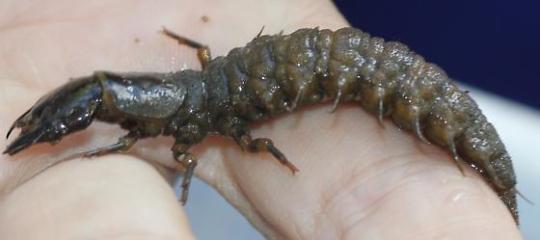
Eastern Dobsonfly (Corydalus cornutus)
Distribution: Found throughout eastern North America, from Canada down to Mexico.
Habitat: Found in or near fast-flowing, unpolluted rivers and streams; larvae live on the stream bottom, while adults are terrestrial (though remain around bodies of water).
Diet: Larvae are active predators, feeding on small invertebrates such as insects, other arthropods, molluscs and worms; preference for the larvae of blackflies, caddisflies and mayflies. Adult females feed on nectar, while males are not known to feed.
Description: Eastern dobsonflies are large, solitary insects. Their most obvious characteristic is the males' oversized mandibles, which can reach up to half the length of its body. Despite the adults' fearsome appearance, however, they're quite harmless. Larvae, however, have powerful mandibles and the capacity to deliver a painful bite.
Dobsonfly larvae, also known as hellgrammites, are commonly used as bait for fishermen. They're important predators of invertebrates in stream ecosystems, and are a natural enemy of blackflies. In habitats where fish are small or absent, large hellgrammites may be the largest predator in the water.
(Images by Kailyn Lianne Liu (adult) and Even Dankowicz (larva))
8 notes
·
View notes
Text
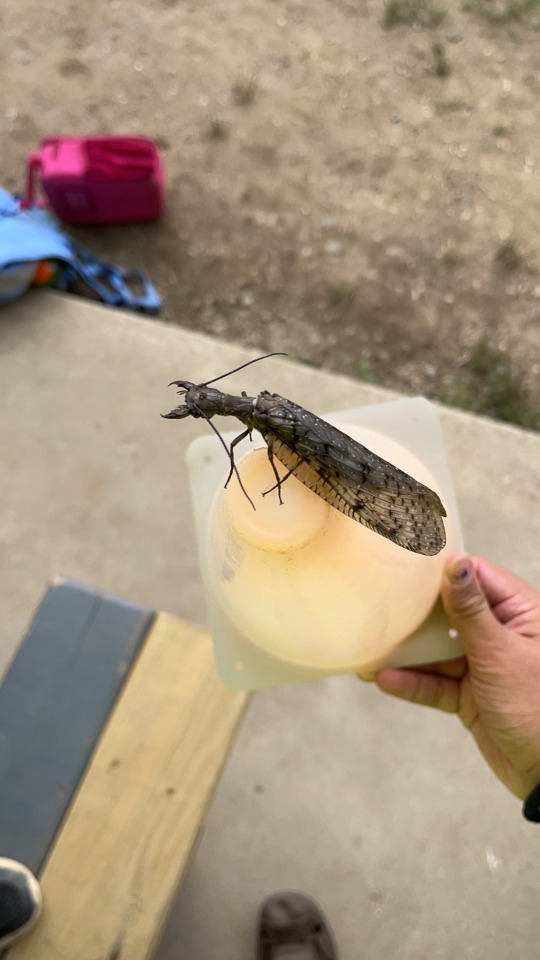
Big-ass bug I found at work today.
A female Eastern Dobsonfly (corydalus cornutus)
Thought it was cool. Crazy to think that it’ll only be alive for like a week or two before mating then dying. Sometimes I envy them…
12 notes
·
View notes
Text

🔁 Ready for halloween 🎃 👻 @truenorthbaits → 🔥Custom designed TNB Hellion🔥
🤓Fun fact: Hellgrammites are the larvae of eastern dobsonflies. They are aquatic, somewhat flattened, and usually some shade of dark brown, tan, or black. Some people think they look like centipedes. The head is equipped with a pair of large, sharp pincers that can deliver a painful bite.
#truenorthbaits #custombaits #supportsmallbusiness #hellgrammite #bassfishing https://www.instagram.com/p/CjlTGVNtD2o/ https://tackle.net
0 notes
Text
#nature#entomology#bug#insect#video#megaloptera#dobsonfly#eastern dobsonfly#corydalus cornutus#corydalidae#mine#tiktok
406 notes
·
View notes
Text
@dagnalthepyro submitted: Found this lad at my work in south St. Louis, Missouri. Was about 4 inches long. Never seen one of these before. Any idea what it is?
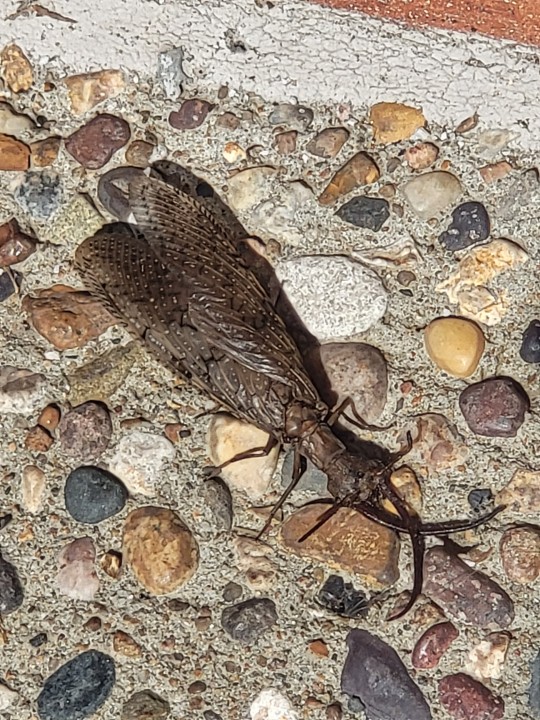
Yepppp it’s a male eastern dobsonfly. Females will have smaller jaws :)
85 notes
·
View notes
Photo



[Image Description: Three images of the same bug. In all three, they are close-up images of a large bug (about 2-3 inches long) clinging to the outside of a window screen. The first is a side view of the bug, where you can see its large greenish eyes and it’s grey-tan body. The second is a top view, where you can see more detail of the translucent wings, and the feathering of the antennae. The third is a view of it spreading its wings out as though it were about to fly, making them more obviously translucent.]
One of the best parts about being “that weirdo who likes bugs” is that gradually all your friends figure it out and then excitedly drag you over whenever they see a cool bug! Such was the case with this big beauty, in the midst of one of the late-night parties at Pinewoods camp. I didn’t even know the friend in question liked bugs, and after I took a bunch of pictures, we went inside to borrow a bug book and try and ID it.
(Any quality dance camp should have a number of reference books available, on the local flora and fauna. I’m trying to grow my own small collection as well, but it’s convenient to not have to carry the library with me.)
We were ten minutes of flipping through pages in, when my Adventure Buddy wandered over and glanced at the photo on my camera screen. “Oh, what a nice Eastern Dobsonfly!” (Corydalus cornutus) says he, and one flip to the correct section later, we’ve confirmed he’s right! It’s a female Dobsonfly, which my more recent research implies is capable of delivering a pretty nasty bite! I’m a little bummed I didn’t get a closer picture of her powerful mandibles...but then again, maybe I didn’t want to get *too* close!
There are varieties of Dobsonflies all over the world, some of which can grow to have as much as a seven or eight inch wingspan! They live a short life, about a week at most, and spend it trying to ensure the continuation of their magnificent species. I’m a bit disappointed I couldn’t spot a male Dobsonfly as well, as the gents have significant mandibles, long enough to almost be mistaken for another set of antennae!
Image Credit: I took this one! CC-BY-NC CitySpider 2018
#insect#cityspider photos#identified#bugs (colloquial)#nature#cityspider#animals#eastern dobsonfly#corydalus cornutus#pinewoods camp#massachusetts#northeastern usa#goals#City Spider Does Nature
3 notes
·
View notes
Photo
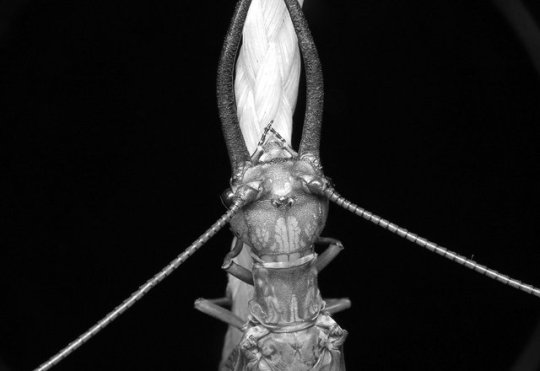
Bug of the Day
I was participating in that silly black & white photo meme on Facebook and came up with this dobsonfly gem. I loved it so much, I had to post it here! It reminds me of a Janet Jackson video for some reason...
#dobsonfly#Eastern Dobsonfly#Corydalus cornutus#Corydalus#Corydalidae#Megaloptera#insect#black and white#missjacksonifyourenasty
82 notes
·
View notes